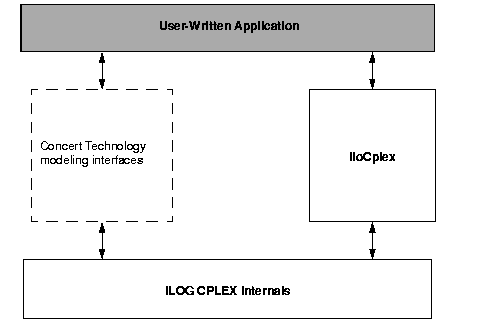Architecture of a CPLEX Java Application
 PREVIOUS
NEXT
PREVIOUS
NEXT
| ILOG CPLEX 11.0 User's Manual > Languages and APIs > ILOG Concert Technology for Java Users > Architecture of a CPLEX Java Application |
Architecture of a CPLEX Java Application |
INDEX
 PREVIOUS
NEXT
PREVIOUS
NEXT
|
A user-written application first creates an IloCplex object. It then uses the Concert Technology modeling interface implemented by IloCplex to create the variables, the constraints, and the objective function of the model to be solved. For example, every variable in a model is represented by an object that implements the Concert Technology variable interface IloNumVar. The user code accesses the variable only through its Concert Technology interface. Similarly, all other modeling objects are accessed only through their respective Concert Technology interfaces from the user-written application, while the actual objects are maintained in the ILOG CPLEX database.
Figure 2.1 illustrates how an application uses Concert Technology, IloCplex, and the ILOG CPLEX internals. The Java interfaces, represented by the dashed outline, do not actually consume memory. The ILOG CPLEX internals include the computing environment, its communication channels, and your problem objects.
For users familiar with object-oriented design patterns, this design is that of a factory, where IloCplex is a factory for modeling objects. The advantage of such a design is that code which creates a model using the Concert Technology modeling interface can be used not only with IloCplex, but also with any other factory class, for instance IloSolver. This allows you to try different ILOG optimization technologies for solving your model.

| Copyright © 1987-2007 ILOG S.A. All rights reserved. Legal terms. | PREVIOUS NEXT |